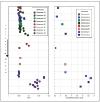About This Item
- Full text of this item is not available.
- Abstract PDFAbstract PDF(no subscription required)
Share This Item
The AAPG/Datapages Combined Publications Database
Houston Geological Society Bulletin
Abstract
Abstract: Integration of Inorganic/Organic Geochemistry and Geomechanical Stratigraphy to Characterize Permian Shale Plays
This study presents an integrated inorganic/organic geochemistry and geomechanical stratigraphic methods to characterize Permian organic rich mudstones in the Midland Basin, to understand controls on organic carbon richness, such as primary productivity, depositional environments, sediment supply, and bottom water preservation conditions, and its implications on petroleum generation/charge and on shale oil development.
A high frequency sampling of core samples from a thick sequence (∼1000 ft) of argillaceous mudstones, organic-rich mudstones, siliceous mudstones, and carbonate mudstones in the Midland basin were characterized for elemental concentrations and source rock geochemistry, and for high resolution gas chromatography and biomarkers on extracts. The small maturity differences from the top to the bottom of this 1000 ft section and limited migration of hydrocarbons into the rock pore space due to low permeability and high capillary entry pressure allows us to interpret the extract geochemistry fingerprints to compositions of the source rock kerogen and its in-situ generated bitumen.
 Figure 1. Elemental
Figure 1. Elemental  data
data were used to define the minerology and lithology of this cored section and then chemozones (right) reflecting depositional environment variation of para-sequences. Extract organic geochemistry
were used to define the minerology and lithology of this cored section and then chemozones (right) reflecting depositional environment variation of para-sequences. Extract organic geochemistry  data
data (Pristane/Phytane ratios, left) suggested corresponding changes in sedimentary diagenetic conditions.
(Pristane/Phytane ratios, left) suggested corresponding changes in sedimentary diagenetic conditions.
Geologic, petrophysical, and elemental analysis have divided the section into many depositional packages (chemozones) with distinct signatures. This has suggested cycles of para-sequences with varied sediment (clastic vs carbonate) supply, a likely shift in detrital sediment source and organic matter  input
input , and also changes in bottom water oxygen conditions during the deposition of these organic rich mudstone units. Specifically variations in elemental parameters indicative of detrital sources suggest a significant shift of sediment source area/provenance, probably associated with the transition of late Permian glacial/interglacial climate. A corresponding change in organic matter
, and also changes in bottom water oxygen conditions during the deposition of these organic rich mudstone units. Specifically variations in elemental parameters indicative of detrital sources suggest a significant shift of sediment source area/provenance, probably associated with the transition of late Permian glacial/interglacial climate. A corresponding change in organic matter  input
input is also observed across the glacial/interglacial transition zone. Source rock characters respond to these depositional environmental variations with changes in total organic carbon contents and hydrogen/oxygen index values. Depositional environment dependent biomarker parameters (Pristane/Phytane, Dibenzothiophene/Phenanthrene, etc.) from core extracts also show systematic changes reflecting variations in source rock facies and preservation conditions. Primary productivity, as proxied by Ni concentration in sediment, is the best parameter to explain organic matter enrichment in these sediments, combined with a possible increase in sedimentary anoxia. This integrated approach greatly enhances our understanding of these Permian age resource play petroleum systems, which in turn helps with sweetspot mapping and lateral landing zone definition.
is also observed across the glacial/interglacial transition zone. Source rock characters respond to these depositional environmental variations with changes in total organic carbon contents and hydrogen/oxygen index values. Depositional environment dependent biomarker parameters (Pristane/Phytane, Dibenzothiophene/Phenanthrene, etc.) from core extracts also show systematic changes reflecting variations in source rock facies and preservation conditions. Primary productivity, as proxied by Ni concentration in sediment, is the best parameter to explain organic matter enrichment in these sediments, combined with a possible increase in sedimentary anoxia. This integrated approach greatly enhances our understanding of these Permian age resource play petroleum systems, which in turn helps with sweetspot mapping and lateral landing zone definition.
 Figure 2. Depth profiles of Ti/Al ratio (left) and C30 Sterane index (right) show corresponding changes in detrital sediment
Figure 2. Depth profiles of Ti/Al ratio (left) and C30 Sterane index (right) show corresponding changes in detrital sediment  input
input and organic matter sources, possibly related to Late Permian glacial/interglacial transition.
and organic matter sources, possibly related to Late Permian glacial/interglacial transition.
Biographical Sketch
Dr. Gong is currently a geological advisor for Apache Corporation's Energy Technology and Technical Services. His specialty covers all  aspects
aspects of petroleum systems analysis including evaluation of source rocks and petroleum fluid (oil/gas/water) geochemistry; reservoir geochemistry for well communication and production allocation; basin history, source rock maturation, generation, and migration modeling; petroleum charge risking and sweetspot mapping for both resource plays and conventional systems.
of petroleum systems analysis including evaluation of source rocks and petroleum fluid (oil/gas/water) geochemistry; reservoir geochemistry for well communication and production allocation; basin history, source rock maturation, generation, and migration modeling; petroleum charge risking and sweetspot mapping for both resource plays and conventional systems.
He started his petroleum industry career in 1998 as a Senior Petroleum Geologist/Research Geochemist for ExxonMobil in its New Business Development, Gulf of Mexico Exploration, and Upstream Research groups. Then he worked at BP for six years as a Petroleum Systems Analyst in its Gulf of Mexico Exploration and Exploration/Production Technology groups. He joined Apache in 2011 and has supported E&P activities in world-wide basins such as Permian, Anadarko, Egypt Western Desert, North Sea, Gulf of Mexico, Neuquén, Northwest Shelf of Australia, Guyana, WCSB, and Rocky Mountain basins. Prior to coming to U.S., he was a lecturer on economic geology and natural resources in Hefei University of Technology, China.
He holds Bachelor's and Master's degrees in Economic Geology from China's Hefei University of Technology, and a Master's degree in Geology from the University of Alabama, and a Doctor's degree in Geological Sciences from Northwestern University.
Copyright © 2019 by HGS (Houston Geological Society)
